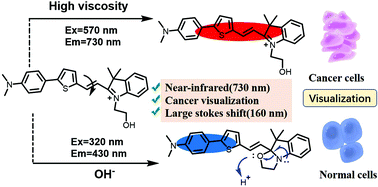Dual-channel detection of viscosity and pH with a near-infrared fluorescent probe for cancer visualization†
Abstract
Compared to ordinary cells, tumor cells have a unique microenvironment, characterized by high viscosity, low pH, high reactive oxygen species level and the overexpression of certain proteases. Therefore, viscosity and pH can be used as important parameters for visualizing cancer. We designed a spiro-oxazolidine compound (In-1) for the dual-channel detection of viscosity and pH, with the red channel for detecting viscosity and the blue channel for pH. Interestingly, In-1 can locate different organelles under different conditions. Under physiological conditions, In-1 efficiently targeted lysosomes and showed that the viscosity of lysosomes increases in cancer cells while the pH decreases, which can be used to distinguish and detect cancer cells and normal cells. When we treated HL-7702 cells with CCCP, the probe could effectively target the mitochondria, and the fluorescence intensity in the pH channel decreased. This indicates that In-1 can be used as a powerful tool to simultaneously monitor viscosity and pH in different organelles, and may have a guiding role in diseases caused by mitochondrial and lysosomal microenvironments.



 Please wait while we load your content...
Please wait while we load your content...